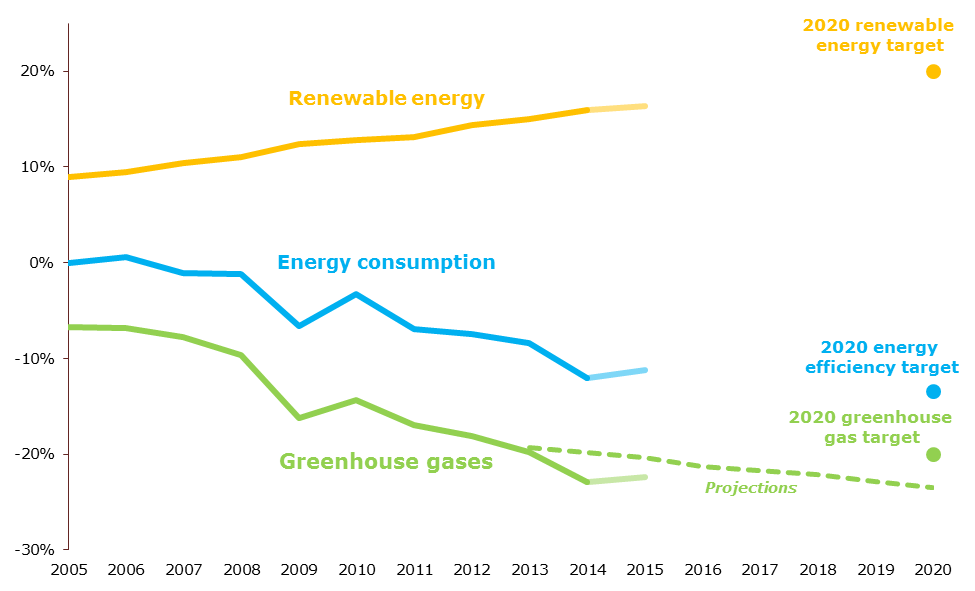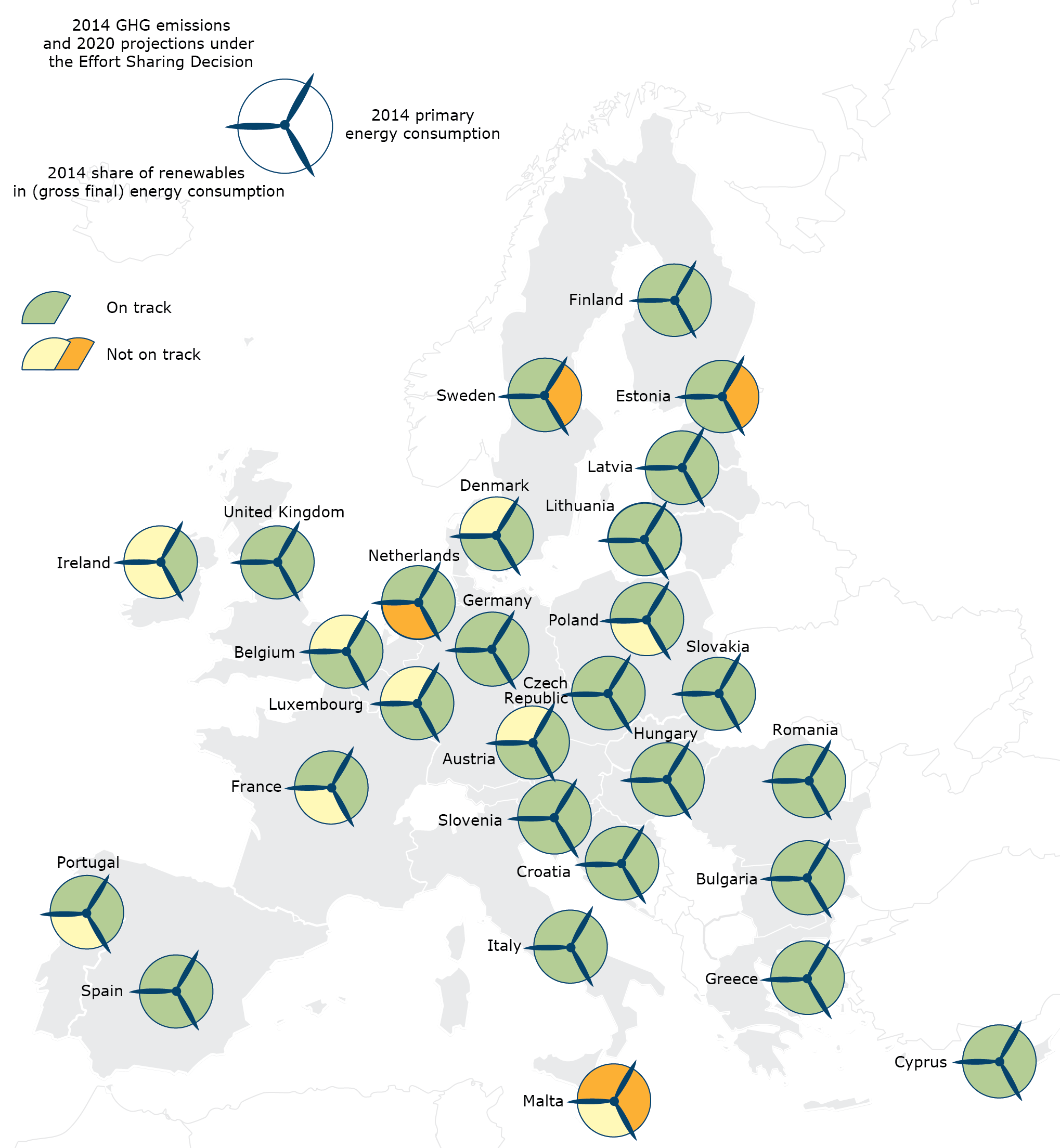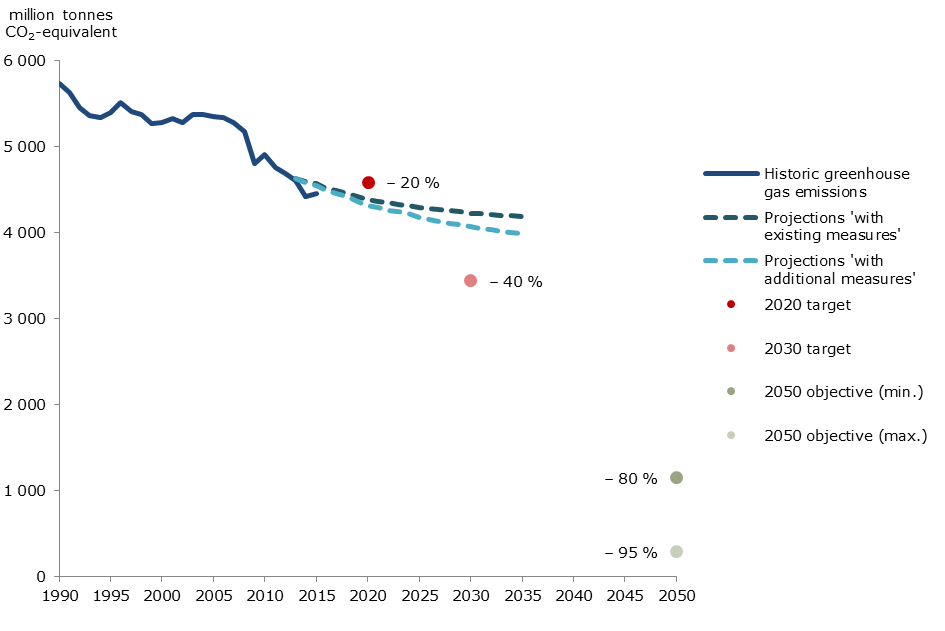Progress of the European Union and its Member States towards 2020 climate and energy targets
The 2016 edition of the European Environment Agency (EEA)Trends and projections in Europereport confirms that the European Union (EU) is well on track to meet its climate and energy targets for 2020. Despite a slight setback in 2015 concerning greenhouse gas (GHG) emissions and energy efficiency, GHG emissions have already decreased below the 20 % reduction target; renewable energy use is growing faster than initially planned by Member States in order to achieve the 20 % target level; and energy consumption is decreasing at a pace that will be sufficient to reach the 2020 energy efficiency target (see Figure ES.1).
According to preliminary estimates, energy consumption and greenhouse gas emissions slightly increased in 2015. These increases follow large reductions in 2014, due to an exceptionally warm winter that year that was responsible for particularly low energy demand for heating.
Policies are playing an important role in driving the overall EU trends observed since 2005, in particular through a continued increase in renewable energy use. However, the transport sector in general is a laggard, both in terms of reducing GHG emissions and achieving the 10 % sectoral target for renewables by 2020.

Note: For renewable energy, the figure represents the trend in the share of energy from renewable sources in gross final energy consumption since 2005. The 2020 renewable energy target corresponds to a share of 20 %.
The 2020 target on energy efficiency was defined as a 20 % saving in energy consumption compared to baseline projections. This is equivalent to a 13 % reduction of primary energy consumption (or an 8 % reduction in final energy consumption) from 2005 levels. The figure represents the relative change in primary energy consumption since 2005.
The 2020 target on greenhouse gas emissions corresponds to a 20 % reduction from 1990 levels. The trends and projections represented on the figure correspond to relative changes in emissions compared to 1990 levels. The projections are presented in the ‘with existing measures’ scenario, which reflects currently adopted policies and measures.
Source: EC, 2013; EEA, 2011, 2016a, 2016b, 2016c and 2016d; EU, 2009 and 2012; European Council, 2007; Eurostat, 2016a, 2016b and 2016c.

Note: The colours indicate whether countries are considered on track or not towards their 2020 climate and energy targets.
For greenhouse gases, orange means that 2014 emissions covered by the Effort Sharing Decision (ESD) were above the 2014 national ESD target. Yellow means that projected ESD emissions in the ‘with existing measures’ scenario for 2020 are above the 2020 national ESD target.
For renewable energy, orange means that the 2014 share of energy from renewable sources (RES) in gross final energy consumption was below the indicative level from the Renewable Energy Directive. Yellow means that the 2014 RES share was below the indicative level from the national action plan from 2010.
For energy efficiency, orange means that the 2014 consumption in primary energy was above a linear indicative trajectory between the 2005 level and the 2020 national target.
Further methodological details on how progress is measured are provided in Annexes 1, 2 and 3.
Source: National information reported by Member States to the EEA, the European Commission and Eurostat. See Chapters 3, 5 and 7 for further details, as well as Annexes 1, 2 and 3 for information on data and methodology.
The report also uses official data for 2014 to look at the progress of Member States towards their individual objectives for 2020 (see Figure ES.2). Here progress is mixed: while the EU is on track, the situation differs between Member States.
- 22 Member States are on track to meet their 2020 GHG targets under the Effort Sharing Decision, which cover national emissions from sectors outside the EU Emissions Trading System (ETS). All except Austria, Belgium, Denmark, Ireland and Luxembourg project that their GHG emissions will be kept or reduced below their national targets in 2020, with the current set of policies and measures in place. Malta did not reach its 2014 ESD target.
- 22 Member States are on track to reach their 2020 renewable energy targets: all except France, Ireland, Malta, the Netherlands, Poland and Portugal used more renewable energy than the levels indicated in their national action plans for the year 2014. The Netherlands did not reach the minimum level indicated in the Renewable Energy Directive.
- 25 Member States (all except Estonia, Malta and Sweden) are on track to meet their 2020 energy efficiency targets, on the basis of their consumption of primary energy in 2014. However, some Member States show a lack of ambition with regard to reducing or limiting their energy consumption: the 28 Member States’ self-defined 2020 targets for primary energy consumption do not amount to a level in line with the reduction target determined at the EU level.
A total of 17 Member States are on track to deliver on their national targets in all three areas. This is an improvement on 2014, when the figure was 13. However, for the first time that this analysis is made, one Member State (Malta) is experiencing difficulties in staying on track in any of the three areas.
EU progress towards 2030 climate and energy targets
Although the EU is expected to achieve its 2020 targets, current efforts need to be stepped up to achieve more ambitious longer term objectives. For example, while projections show further decreases in EU GHG emissions beyond 2020, Member States project that the pace of these reductions will slow down. The reductions currently planned fall short of the 40% reduction target for 2030.
Maintaining the current pace of renewable energy deployment across Europe would enable the EU to achieve the target of sourcing at least 27 % of its gross final consumption of energy from renewable sources by 2030. However, this may not happen without additional effort, because regulatory changes affect investors’ confidence in renewables, and market barriers still prevent new competitors from easily entering the renewable energy sector.
Concerning energy efficiency, continuing the current trends in energy consumption would be sufficient to achieve the 27 % target for energy efficiency in 2030. This would only require a somewhat limited change in the EU’s energy system. Achieving the 2030 targets nevertheless requires not only the effective implementation of energy efficiency measures, but also a rapid change in consumer behaviour.
Policy proposals are currently under discussion between Member States and at the European Parliament in order to achieve the EU’s 2030 objectives under the climate and energy framework and the Energy Union Framework Strategy. These include a revision of the EU ETS, new binding national targets on GHG emissions for the period from 2021 to 2030 under the Effort Sharing Regulation, and the integration of land use and forestry in the policy framework. The Commission is also scheduled to table proposals for revising the Renewable Energy and the Energy Efficiency Directives, as well as rules for the electricity market.
A new governance system is also being developed in order to ensure that these policies and measures adequately support the transition to a low-carbon, competitive EU economy. The proposed new governance includes (1) a structured, political dialogue between the Commission, Member States and other EU institutions; (2) streamlined planning, reporting and monitoring across the energy and climate fields; and (3) stronger regional cooperation.
Outlook for greenhouse gas trends in 2050
The 2016 analysis of progress towards long-term decarbonisation targets in the EU has not changed since the 2015 assessment: although the EU and its Member States are making good progress towards their short-term goals on climate and energy, they will have to intensify their efforts considerably to meet longer-term energy and decarbonisation objectives for 2050. The pace of GHG emission reductions after 2020 should actually increase in order to achieve targets, rather than slow down as is currently projected by Member States. Assuming the necessary emission cuts required to achieve the 2030 target actually take place, an even deeper reduction would still need to be achieved between the 2030 target level (40 % below 1990 levels) and the EU objective for 2050 (at least 80 % below 1990 levels). This reduction will have to be two to three times greater than the decrease from current levels necessary to meet the 2030 target, which is itself greater than that achieved since 1990. In short, ambition levels need to be stepped up.
As underlined in the EEA report,The European environment - state and outlook 2015, achieving the EU’s long-term decarbonisation objective can take place only in the context of a major transformation of the EU’s socio-technical systems such as the energy, food, mobility and urban systems. As the effects of policies and measures often take time to materialise, action aimed at achieving the long-term targets cannot be delayed. Member States tend to prioritise low-cost mitigation measures, but they should also take into consideration the long-term mitigation potential of other measures, including those that are often postponed because of high current costs or other difficulties related to their implementation. Investments in these measures often make economic sense, even in the short term, as they significantly contribute to the generation of learning effects and thereby foster future cost reductions.

Note: The greenhouse gas emission trends, projections and targets include emissions from international aviation, and exclude emissions and removals from the land-use sector. The ‘with existing measures’ (WEM) scenario reflects existing policies and measures, while the ‘with additional measures’ (WAM) scenario takes into account the additional effects of planned measures reported by Member States. For the most part, these projections were reported in 2015 and therefore do not reflect the expected effects of recent policy proposals such as the reform of the EU ETS and other measures in non-ETS sectors for the period after 2020.
Source: EEA, 2016a, 2016b, 2016c and 2016d.
About this report
The 2016 edition of the annual EEA report,Trends and projections in Europe,provides an updated assessment of the progress of the EU and European countries towards their climate mitigation and energy targets. The report is mainly based on national data on GHG emissions, renewable energy and energy consumption for 2014, preliminary (‘approximated’ or ‘proxy’) data for 2015 and projections reported by Member States concerning expected trends in GHG emissions until 2035.
EEA reports
This report is part of an annual series of EEA reports on climate change and energy. In particular, this report is linked to the EEA report No 23/2016, Approximated EU GHG inventory: Proxy GHG emission estimates for 2015,and the EEA report No 24/2016, Trends and projections in the EU ETS in 2016 — The EU Emissions Trading System in numbers. All EEA reports are available at: eea.europa.eu.
About the EEA
The European Environment Agency (EEA) is an agency of the European Union. It aims to support sustainable development and to help achieve significant and measurable improvement in Europe's environment by providing timely, targeted, relevant and reliable information to policymaking agents and the public. It is supported in its work by the European environment information and observation network (Eionet), a network of 39 European countries.
Authors
This report was prepared by the European Environment Agency (EEA) and its European Topic Centre for Air Pollution and Climate Change Mitigation (ETC/ACM). The ETC/ACM is a consortium of European institutes that assist the EEA in its support to European Union (EU) policy in the field of air pollution and climate change mitigation.
The overall coordination of the report was carried out by François Dejean (EEA) and the ETC/ACM task manager, Sabine Gores (Öko-Institut, Germany).
The authors were, in alphabetical order, Anca-Diana Barbu, François Dejean and Mihai Tomescu (EEA); Hannes Böttcher, Hannah Förster, Sabine Gores, Sean Healy (Öko-Institut, Germany), and Nele Renders (Vito, Belgium).



Document Actions
Share with others